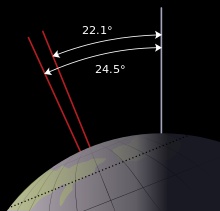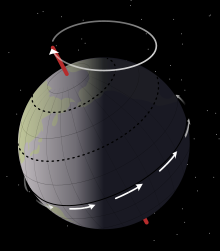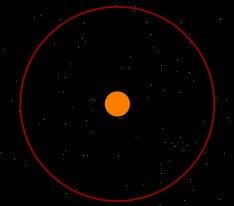From Wikipedia, the free encyclopedia

Past and future Milankovitch cycles. VSOP allows prediction of past and future orbital parameters with great accuracy.
— ε is obliquity (axial tilt).
— e is eccentricity.
— ϖ is longitude of perihelion.
— e sin(ϖ) is the precession index, which together with obliquity, controls the seasonal cycle of insolation.
— is the calculated daily-averaged insolation at the top of the atmosphere, on the day of the summer solstice at 65 N latitude.
is the calculated daily-averaged insolation at the top of the atmosphere, on the day of the summer solstice at 65 N latitude.
— Benthic forams and — Vostok ice core show two distinct proxies for past global sealevel and temperature, from ocean sediment and Antarctic ice respectively.
The vertical gray line shows current conditions, at 2 ky A.D.
— ε is obliquity (axial tilt).
— e is eccentricity.
— ϖ is longitude of perihelion.
— e sin(ϖ) is the precession index, which together with obliquity, controls the seasonal cycle of insolation.
—
 is the calculated daily-averaged insolation at the top of the atmosphere, on the day of the summer solstice at 65 N latitude.
is the calculated daily-averaged insolation at the top of the atmosphere, on the day of the summer solstice at 65 N latitude.— Benthic forams and — Vostok ice core show two distinct proxies for past global sealevel and temperature, from ocean sediment and Antarctic ice respectively.
The vertical gray line shows current conditions, at 2 ky A.D.
Milankovitch theory describes the collective effects of changes in the Earth's movements upon its climate, named after Serbian geophysicist and astronomer Milutin Milanković, who worked on it during his internment as a POW during the First World War. Milanković mathematically theorized that variations in eccentricity, axial tilt, and precession of the Earth's orbit determined climatic patterns on Earth through orbital forcing.
The Earth's axis completes one full cycle of precession approximately every 26,000 years. At the same time, the elliptical orbit rotates more slowly. The combined effect of the two precessions leads to a 21,000-year period between the astronomical seasons and the orbit. In addition, the angle between Earth's rotational axis and the normal to the plane of its orbit (obliquity) oscillates between 22.1 and 24.5 degrees on a 41,000-year cycle. It is currently 23.44 degrees and decreasing.
Similar astronomical theories had been advanced in the 19th century by Joseph Adhemar, James Croll and others, but verification was difficult due to the absence of reliably dated evidence and doubts as to exactly which periods were important. Not until the advent of deep-ocean cores and a seminal paper by Hays, Imbrie, and Shackleton, "Variations in the Earth's Orbit: Pacemaker of the Ice Ages", in Science (1976)[1] did the theory attain its present state.
Earth’s movements
As the Earth spins around its axis and orbits around the Sun, several quasi-periodic variations occur due to gravitational interactions. Although the curves have a large number of sinusoidal components, a few components are dominant.[2] Milankovitch studied changes in the orbital eccentricity, obliquity, and precession of Earth's movements. Such changes in movement and orientation alter the amount and location of solar radiation reaching the Earth. This is known as solar forcing (an example of radiative forcing). Changes near the north polar area, about 65 degrees North, are considered important due to the great amount of land. Land masses respond to temperature change more quickly than oceans, which have a higher effective heat capacity, because of the mixing of surface and deep water and the fact that the specific heat of solids is generally lower than that of water.Orbital shape (eccentricity)
The Earth's orbit is an ellipse. The eccentricity is a measure of the departure of this ellipse from circularity. The shape of the Earth's orbit varies in time between nearly circular (low eccentricity of 0.000055) and mildly elliptical (high eccentricity of 0.0679)[3] with the mean eccentricity of 0.0019 as geometric or logarithmic mean and 0.034 as arithmetic mean, the latter useless. The major component of these variations occurs on a period of 413,000 years (eccentricity variation of ±0.012). A number of other terms vary between components 95,000 and 125,000 years (with a beat period 400,000 years), and loosely combine into a 100,000-year cycle (variation of −0.03 to +0.02). The present eccentricity is 0.017 and decreasing.
If the Earth were the only planet orbiting our Sun, the eccentricity of its orbit would not perceptibly vary even over a period of a million years. The Earth's eccentricity varies primarily due to interactions with the gravitational fields of Jupiter and Saturn. As the eccentricity of the orbit evolves, the semi-major axis of the orbital ellipse remains unchanged. From the perspective of the perturbation theory used in celestial mechanics to compute the evolution of the orbit, the semi-major axis is an adiabatic invariant. According to Kepler's third law the period of the orbit is determined by the semi-major axis. It follows that the Earth's orbital period, the length of a sidereal year, also remains unchanged as the orbit evolves.
Orbital shape and Temperature
As the semi-minor axis is decreased with the eccentricity increase, the seasonal changes increase.[4] But the mean solar irradiation for the planet changes only slightly for small eccentricity, due to Kepler's second law. Season is not solely by distance from sun, see: Season.The same average irradiation does not correspond to the average of corresponding temperatures (due to non-linearity of the Stefan–Boltzmann law). For an irradiation with corresponding temperature 20 °C and its symmetric variation ±50% (e.g. from the seasons change[5]) we obtain asymmetric variation of corresponding temperatures with their average 16 °C (i.e. deviation −4 °C)[clarification needed]. And for the irradiation variation during a day (with its average corresponding also to 20 °C) we obtain the average temperature (for zero thermal capacity) −113 °C.[clarification needed]
The relative increase in solar irradiation at closest approach to the Sun (perihelion) compared to the irradiation at the furthest distance (aphelion) is slightly larger than four times the eccentricity. For the current orbital eccentricity this amounts to a variation in incoming solar radiation of about 6.8%, while the current difference between perihelion and aphelion is only 3.4% (5.1 million km). Perihelion presently occurs around January 3, while aphelion is around July 4. When the orbit is at its most elliptical, the amount of solar radiation at perihelion will be about 23% more than at aphelion.
The higher eccentricity also causes extra behavior in due to precession and axial tilt (see Season). The true global summer does not appear to be the warmer part of the year in the North (until an eon from now when balanced). Seasons always arrive early (see Mean tropical year) but not the same for differning seasons, since elliple motion (speed, angle) to sun differs per season arrival.
| Year | Northern Hemisphere | Southern Hemisphere | Date: GMT | Season duration |
|---|---|---|---|---|
| 2005 | Winter solstice | Summer solstice | 21 December 2005 18:35 | 88.99 days |
| 2006 | Spring equinox | Autumn equinox | 20 March 2006 18:26 | 92.75 days |
| 2006 | Summer solstice | Winter solstice | 21 June 2006 12:26 | 93.65 days |
| 2006 | Autumn equinox | Spring equinox | 23 September 2006 4:03 | 89.85 days |
| 2006 | Winter solstice | Summer solstice | 22 December 2006 0:22 | 88.99 days |
| 2007 | Spring equinox | Autumn equinox | 21 March 2007 0:07 | 92.75 days |
| 2007 | Summer solstice | Winter solstice | 21 June 2007 18:06 | 93.66 days |
| 2007 | Autumn equinox | Spring equinox | 23 September 2007 9:51 | 89.85 days |
| 2007 | Winter solstice | Summer solstice | 22 December 2007 06:08 |
Changes to the eccentricity do not by themselves change the length of the anomalistic year or the Earth's mean motion along its orbit since they are both functions of the semi-major axis.
Axial tilt (obliquity)

The angle of the Earth's axial tilt (obliquity of the ecliptic) varies with respect to the plane of the Earth's orbit. These slow 2.4° obliquity variations are roughly periodic, taking approximately 41,000 years to shift between a tilt of 22.1° and 24.5° and back again. When the obliquity increases, the amplitude of the seasonal cycle in insolation increases, with summers in both hemispheres receiving more radiative flux from the Sun, and winters less. Conversely, when the obliquity decreases, summers receive less insolation and winters more.
But these changes of opposite sign in summer and winter are not of the same magnitude everywhere on the Earth's surface. At high latitude the annual mean insolation increases with increasing obliquity, while lower latitudes experience a reduction in insolation. Cooler summers are suspected of encouraging the onset of an ice age by melting less of the previous winter's precipitation. Because most of the planet's snow and ice lies at high latitude, it can be argued that lower obliquity favors ice ages for two reasons: the reduction in overall summer insolation and the additional reduction in mean insolation at high latitude.
Scientists using computer models to study more extreme tilts than those that actually occur have concluded that climate extremes at high obliquity would be particularly threatening to advanced forms of life that presently exist on Earth. They noted that high obliquity would not likely sterilize a planet completely, but would make it harder for fragile, warm-blooded land-based life to thrive as it does today.[7]
Currently the Earth is tilted at 23.44 degrees from its orbital plane, roughly halfway between its extreme values. The tilt is in the decreasing phase of its cycle, and will reach its minimum value around the year 11,800 CE ; the last maximum was reached in 8,700 BCE. This trend in forcing, by itself, tends to make winters warmer and summers colder (i.e. milder seasons), as well as cause an overall cooling trend.
Axial precession

Precession is the trend in the direction of the Earth's axis of rotation relative to the fixed stars, with a period of roughly 26,000 years. This gyroscopic motion is due to the tidal forces exerted by the Sun and the Moon on the solid Earth, which has the shape of an oblate spheroid rather than a sphere. The Sun and Moon contribute roughly equally to this effect.
When the axis points toward the Sun in perihelion (i.e. the north pole is pointed towards the Sun), the northern hemisphere has a greater difference between the seasons while the southern hemisphere has milder seasons. When the axis points away from the Sun in perihelion (i.e. the south pole is pointed towards the Sun), the southern hemisphere has a greater difference between the seasons while the northern hemisphere has milder seasons. The hemisphere that is in summer at perihelion receives much of the corresponding increase in solar radiation, but that same hemisphere in winter at aphelion has a colder winter. The other hemisphere will have a relatively warmer winter and cooler summer.
When the Earth's axis is aligned such that aphelion and perihelion occur near the equinoxes, the northern and southern hemispheres will have similar contrasts in the seasons.
At present, perihelion occurs during the southern hemisphere's summer, and aphelion is reached during the southern winter. Thus the southern hemisphere seasons are somewhat more extreme than the northern hemisphere seasons, when other factors are equal.
Apsidal precession

In addition, the orbital ellipse itself precesses in space, primarily as a result of interactions with Jupiter and Saturn.
Smaller contributions are also made by the sun's oblateness and by the effects of General Relativity that are well known for Mercury. The total orbital precession is in the same sense to the gyroscopic motion of the axis of rotation, shortening the period of the precession of the equinoxes with respect to the perihelion from 25,771.5 to ~21,636 years. Apsidal precession occurs in the plane of the Ecliptic and alters the orientation of the Earth's orbit relative to the Ecliptic. In combination with changes to the eccentricity it alters the length of the seasons.
Orbital inclination
The inclination of Earth's orbit drifts up and down relative to its present orbit. Milankovitch did not study this three-dimensional movement. This movement is known as "precession of the ecliptic" or "planetary precession".More recent researchers noted this drift and that the orbit also moves relative to the orbits of the other planets. The invariable plane, the plane that represents the angular momentum of the Solar System, is approximately the orbital plane of Jupiter. The inclination of Earth's orbit drifts up and down relative to its present orbit with a cycle having a period of about 70,000 years. The inclination of the Earth's orbit has a 100,000-year cycle relative to the invariable plane. This is very similar to the 100,000-year eccentricity period. This 100,000-year cycle closely matches the 100,000-year pattern of ice ages.
It has been proposed that a disk of dust and other debris exists in the invariable plane, and this affects the Earth's climate through several possible means. The Earth presently moves through this plane around January 9 and July 9, when there is an increase in radar-detected meteors and meteor-related noctilucent clouds.[8][9]
A study of the chronology of Antarctic ice cores using oxygen-nitrogen ratios in air bubbles trapped in the ice, which appear to respond directly to the local insolation, concluded that the climatic response documented in the ice cores was driven by northern hemisphere insolation as proposed by the Milankovitch hypothesis (Kawamura et al., Nature, 23 August 2007, vol 448, pp 912–917). This is an additional validation of the Milankovitch hypothesis by a relatively novel method, and is inconsistent with the "inclination" theory of the 100,000-year cycle.
Problems
Because the observed periodicities of climate fit so well with the orbital periods, the orbital theory has overwhelming support. Nonetheless, there are several difficulties in reconciling theory with observations.100,000-year problem
The 100,000-year problem is that the eccentricity variations have a significantly smaller impact on solar forcing than precession or obliquity - according to theory- and hence might be expected to produce the weakest effects.
However, the greatest observed response in regard to the ice ages is at the 100,000-year timescale, even though the theoretical forcing is smaller at this scale.[10] During the last 1 million years, the strongest climate signal is the 100,000-year cycle. In addition, despite the relatively great 100,000-year cycle, some have argued that the length of the climate record is insufficient to establish a statistically significant relationship between climate and eccentricity variations.[11] Various explanations for this discrepancy have been proposed, including frequency modulation[12] or various feedbacks (from carbon dioxide, cosmic rays, or from ice sheet dynamics). Some models can reproduce the 100,000-year cycles as a result of non-linear interactions between small changes in the Earth's orbit and internal oscillations of the climate system.[13][14]

The effects of these variations are primarily believed to be due to variations in the intensity of solar radiation upon various parts of the globe. Observations show climate behavior is much more intense than the calculated variations. Various internal characteristics of climate systems are believed to be sensitive to the insolation changes, causing amplification (positive feedback) and damping responses (negative feedback).
The transition problem refers to the switch in the frequency of climate variations 1 million years ago. From 1–3 million years, climate had a dominant mode matching the 41 ka cycle in obliquity. After 1 million years ago, this switched to a 100 ka variation matching eccentricity, for which no reason has been established.[citation needed]
As mentioned above, at present, perihelion occurs during the southern hemisphere's summer and aphelion during the southern winter. Thus the southern hemisphere seasons should tend to be somewhat more extreme than the northern hemisphere seasons. The relatively low eccentricity of the present orbit results in a 6.8% difference in the amount of solar radiation during summer in the two hemispheres.
Since orbital variations are predictable,[20] if one has a model that relates orbital variations to climate, it is possible to run such a model forward to "predict" future climate. Two caveats are necessary: that anthropogenic effects may modify or even overwhelm orbital effects; and that the mechanism by which orbital forcing influences climate is not well understood. In the most prominent anthropogenic example, orbital forcing from the Milankovitch cycles has been in a cooling phase for millennia, but that cooling trend was reversed in the 20th and 21st centuries due to warming caused by increased anthropogenic greenhouse gas emissions.[21]
The amount of solar radiation (insolation) in the Northern Hemisphere at 65° N seems to be related to occurrence of an ice age. Astronomical calculations show that 65° N summer insolation should increase gradually over the next 25,000 years.[22] A regime of eccentricity lower than the current value will last for about the next 100,000 years.
Changes in northern hemisphere summer insolation will be dominated by changes in obliquity ε. No declines in 65° N summer insolation, sufficient to cause a glacial period, are expected in the next 50,000 years.
An often-cited 1980 study by Imbrie and Imbrie determined that, "Ignoring anthropogenic and other possible sources of variation acting at frequencies higher than one cycle per 19,000 years, this model predicts that the long-term cooling trend that began some 6,000 years ago will continue for the next 23,000 years."[23]
More recent work by Berger and Loutre suggests that the current warm climate may last another 50,000 years.[24]
Stage 5 problem
The stage 5 problem refers to the timing of the penultimate interglacial (in marine isotopic stage 5) that appears to have begun ten thousand years in advance of the solar forcing hypothesized to have caused it (also known as the causality problem)(putative effect precedes cause).Effect exceeds cause

The effects of these variations are primarily believed to be due to variations in the intensity of solar radiation upon various parts of the globe. Observations show climate behavior is much more intense than the calculated variations. Various internal characteristics of climate systems are believed to be sensitive to the insolation changes, causing amplification (positive feedback) and damping responses (negative feedback).
The unsplit peak problem
The unsplit peak problem refers to the fact that eccentricity has cleanly resolved variations at both the 95 and 125 ka periods. A sufficiently long, well-dated record of climate change should be able to resolve both frequencies.[15] However, some researchers[who?] interpret climate records of the last million years as showing only a single spectral peak at 100 ka periodicity.The transition problem
The transition problem refers to the switch in the frequency of climate variations 1 million years ago. From 1–3 million years, climate had a dominant mode matching the 41 ka cycle in obliquity. After 1 million years ago, this switched to a 100 ka variation matching eccentricity, for which no reason has been established.[citation needed]
Identifying dominant factor
Milankovitch believed that decreased summer insolation in northern high latitudes was the dominant factor leading to glaciation, which led him to (incorrectly) deduce an approximate 41 ka period for ice ages.[16] Subsequent research[17][18][19] has shown that ice age cycles of the Quaternary glaciation over the last million years have been at a 100,000-year period, leading to identification of the 100 ka eccentricity cycle as more important, although the exact mechanism remains obscure.Present and future conditions
As mentioned above, at present, perihelion occurs during the southern hemisphere's summer and aphelion during the southern winter. Thus the southern hemisphere seasons should tend to be somewhat more extreme than the northern hemisphere seasons. The relatively low eccentricity of the present orbit results in a 6.8% difference in the amount of solar radiation during summer in the two hemispheres.
Since orbital variations are predictable,[20] if one has a model that relates orbital variations to climate, it is possible to run such a model forward to "predict" future climate. Two caveats are necessary: that anthropogenic effects may modify or even overwhelm orbital effects; and that the mechanism by which orbital forcing influences climate is not well understood. In the most prominent anthropogenic example, orbital forcing from the Milankovitch cycles has been in a cooling phase for millennia, but that cooling trend was reversed in the 20th and 21st centuries due to warming caused by increased anthropogenic greenhouse gas emissions.[21]
The amount of solar radiation (insolation) in the Northern Hemisphere at 65° N seems to be related to occurrence of an ice age. Astronomical calculations show that 65° N summer insolation should increase gradually over the next 25,000 years.[22] A regime of eccentricity lower than the current value will last for about the next 100,000 years.
Changes in northern hemisphere summer insolation will be dominated by changes in obliquity ε. No declines in 65° N summer insolation, sufficient to cause a glacial period, are expected in the next 50,000 years.
An often-cited 1980 study by Imbrie and Imbrie determined that, "Ignoring anthropogenic and other possible sources of variation acting at frequencies higher than one cycle per 19,000 years, this model predicts that the long-term cooling trend that began some 6,000 years ago will continue for the next 23,000 years."[23]
More recent work by Berger and Loutre suggests that the current warm climate may last another 50,000 years.[24]
Other planets in the Solar System
Other planets in the Solar System have been discovered to have Milankovitch cycles. Mostly these cycles are not as intense or complex as the Earth's cycles, but do have a global geological impact with respect to the movement of mobile solids like Water or Nitrogen ices or hydrocarbon lakes.- Mars's polar caps vary in extent due to orbital instability related to a latent Milankovitch cycle. [25][26][27]
- Saturn's moon Titan has a ~60,000-year cycle that changes the location of the methane lakes.[28][29]
- Neptune's moon Triton has a similar variation to Titan with respect to migration of solid nitrogen deposits over long time scales.[30][31][32]






